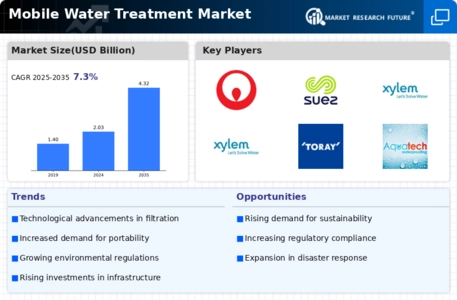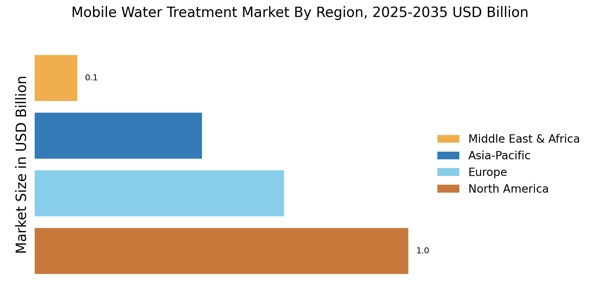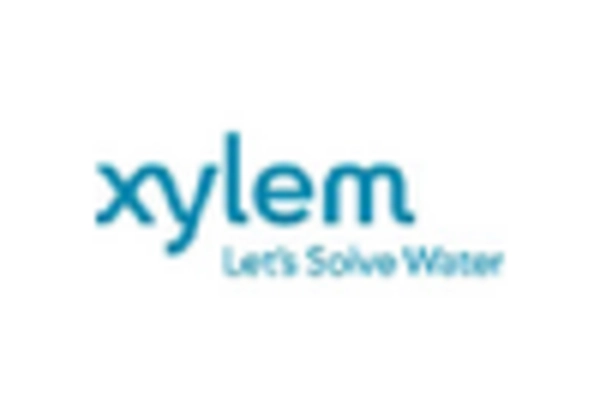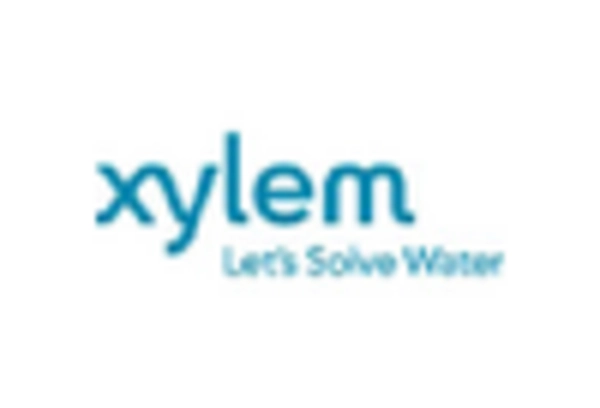Increasing Water Scarcity
The Mobile Water Treatment Market is experiencing growth due to the rising concern over water scarcity. As populations expand and industrial activities increase, the demand for clean water is escalating. Reports indicate that by 2025, nearly 1.8 billion people will be living in areas with absolute water scarcity. This situation compels governments and organizations to invest in mobile water treatment solutions that can provide immediate access to potable water. Mobile units can be deployed quickly to areas facing acute shortages, thus addressing urgent needs. The flexibility and efficiency of these systems make them a preferred choice in regions where traditional infrastructure is lacking or damaged. Consequently, the increasing prevalence of water scarcity is a significant driver for the Mobile Water Treatment Market.
Technological Innovations
The Mobile Water Treatment Market is benefiting from rapid technological advancements that enhance the efficiency and effectiveness of water treatment processes. Innovations such as advanced filtration technologies, real-time monitoring systems, and automated controls are being integrated into mobile units. These technologies not only improve the quality of treated water but also reduce operational costs. For example, the introduction of membrane filtration systems has shown to increase the removal rates of contaminants significantly. As these technologies continue to evolve, they are likely to attract more investments and interest from various sectors, including municipal, industrial, and emergency response. The ongoing technological innovations are thus a crucial driver for the Mobile Water Treatment Market.
Rising Environmental Awareness
The Mobile Water Treatment Market is increasingly driven by a growing awareness of environmental issues. As communities become more conscious of the impact of pollution and waste on water resources, there is a heightened demand for sustainable water treatment solutions. Mobile water treatment systems offer an eco-friendly alternative by minimizing the need for extensive infrastructure and reducing the carbon footprint associated with traditional treatment methods. Furthermore, these systems can be deployed in remote areas, thus preventing the contamination of local water sources. The emphasis on sustainability is prompting both public and private sectors to invest in mobile solutions that align with environmental goals. This shift towards environmentally responsible practices is likely to propel the Mobile Water Treatment Market forward.
Regulatory Compliance and Standards
The Mobile Water Treatment Market is influenced by stringent regulations and standards aimed at ensuring water quality. Governments and regulatory bodies are implementing more rigorous guidelines for water treatment processes, which necessitate the adoption of advanced mobile solutions. For instance, the Environmental Protection Agency has established standards that require certain contaminants to be removed from drinking water. Mobile water treatment systems are designed to meet these compliance requirements effectively, making them essential for municipalities and industries. As organizations strive to adhere to these regulations, the demand for mobile treatment solutions is likely to increase. This trend indicates a growing recognition of the importance of maintaining water quality and safety, thereby driving the Mobile Water Treatment Market.
Emergency Preparedness and Disaster Response
The Mobile Water Treatment Market is significantly influenced by the need for effective emergency preparedness and disaster response strategies. Natural disasters, such as floods and hurricanes, often disrupt water supply systems, leading to immediate needs for clean water. Mobile water treatment units can be rapidly deployed to affected areas, providing essential services in times of crisis. According to recent assessments, the demand for mobile treatment solutions in disaster-stricken regions is expected to rise as governments and NGOs recognize their importance in emergency response plans. These systems not only ensure the availability of safe drinking water but also support recovery efforts by restoring water services quickly. The increasing focus on disaster resilience is thus a vital driver for the Mobile Water Treatment Market.


















Leave a Comment